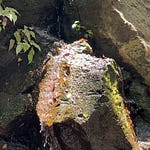Winter in North America always sends huge flocks of birds south to our Central American paradise. While the peskiest of these snowbirds fly in on the aluminum wings of jetliners, uncountable hoards of real birds do it by flapping their real wings. It’s an amazing feat of nature that, despite its annual re-occurrence, always enthralls me. How these spin-offs from the dinosaur era, that weigh a mere hundred-or-so grams, can generate enough energy to fly thousands of miles is an accomplishment man can only dream of.
If you live in that northern, wildly oscillating climate, you may not give much thought to exactly where the birds go when they “fly South for the winter”. Although there are numerous destinations, the rain forests and jungles of Costa Rica are popular with many of these feathered travelers. Our own compound hosts scores of these seasonal vagabonds. They fill our palm trees with intricately engineered nests, hatch their eggs, and then go to war with each other.
Yes, war.
There are Starlings and black birds of several varieties that mix with the native Golden-Bellied Flycatchers and chatty parrots as they compete with each other for the prime nesting spots in our palms. A palm, you see, can really only support a single nest at the very crown of the tree. Build your nest on a lower frond and you’re likely to see it collapse to the ground before those babies are ready to take wing.
As a result, competition for the prime penthouses is fierce, and never ending. I have seen birds clash with each other mid-air, and literally fall to the ground in an entangled mesh of mad birds. I’ve even broken up a few of these battles as they happened right at my feet while drinking my morning coffee.
What I never gave much thought to is where these birds came from and how they ended up here. Yes, they flew south from someplace cold, and landed someplace warm. Specifically, here. But is there more to it than that? Do they, like the human snowbirds, begin and end their voyage in an exact location? I have evidence that suggests the answer is an emphatic, “Yes!”
Four North-American winters ago, a Starling with a unique challenge appeared around the edge of our swimming pool. I don’t know if it’s a he or a she, but I’m going to simplify the story by naming the bird “Wingnut”.
I immediately felt sorry for Wingnut because, while the other birds strolled around the cement watering hole, Wingnut had to limp. It’s left leg, from the backward-bending ankle on down, was missing. The most likely explanation is that the handicap was the result of a viscous battle to protect it’s babies.
But Wingnut, rather than curling up and dying, was undeterred. It popped around on one leg almost as deftly as the two-footed birds, only occasionally putting its stump to the ground to maintain balance. When it flew up to the trees, Wingnut managed to perch on the palm fronds in a one-footed stance that practically defied gravity. Spring came to the northern hemisphere and Wingnut, apparently, went with it.
Imagine my surprise when, the next January, I saw a bird with a missing left leg hopping around the pool. Could it possibly be the very same bird that had flown away eight months ago? After watching its behavior for a few days, I had to conclude that, yes, Wingnut had returned to the very same spot it had wintered the year before.
Wingnut had a partner and successfully raised a nest full of babies. During that time I watched Wingnut valiantly hop on one leg as it gathered shredded palm fronds to build the nest, find food for the brood, and defend its homestead. Not one time did that missing appendage seem to deter Wingnut’s expeditions.
Ditto for last year. There was Wingnut again, going about life as though birds were meant to pop around on a single leg.
This year, for the fourth time, Wingnut is spending the winter months with us. I would love to know where this bird spends it’s summer months, but I know for certain that the same bird spends every late December through April at the very same address. Wingnut’s tenacity is truly inspiring.
The lesson I take from this tiny observation of nature is that we all have it in us to succeed. You have it within you. No matter the challenge. No matter the handicaps you endure. No matter the difficulty of your personal journey. There is a way to succeed. And if you latch onto life with every fiber of your being, you will find that way.
A little birdy told me so.













Share this post